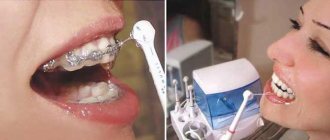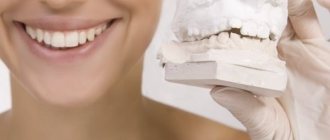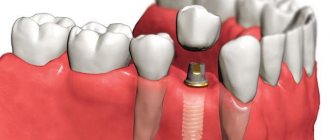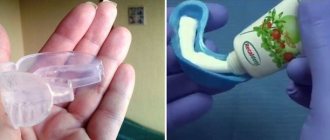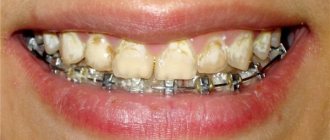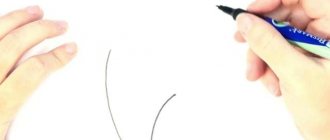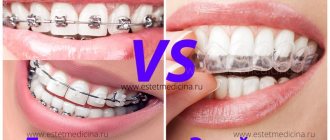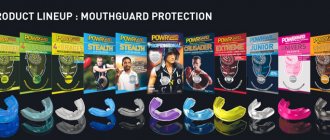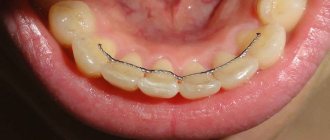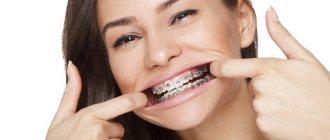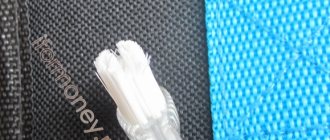Why do you need a dental guard after braces?
Braces correct the bite. This may take several months or even years. When the orthodontic appliance is finally removed, the patient experiences relief. But not everyone knows that after removing braces, teeth can return to their previous incorrect position. This is due to the structural features of the jaw and the physiology of the body, for which it is natural to resist outside interference.
In this article
- Why do you need a dental guard after braces?
- Types of removable mouthguards
- Advantages and disadvantages of removable aligners
- How is an orthodontic mouth guard installed?
- How long do you wear mouthguards after braces?
- How to care for aligners after braces?
- How to wear mouth guards after braces without damaging them?
- Conclusion
In order to prevent repeated curvature of teeth and to maintain the effect of bite correction achieved during orthodontic treatment, the orthodontist prescribes the patient to wear retainers. These are special structures that are worn during the retention period - a time when there is a risk of the tooth returning to its usual position. Retainers hold the teeth in the desired position and allow the ligaments to “get used” to the new bite.
Retainers are removable and non-removable. The latter are wires fixed on the inside of the teeth. A more convenient and popular option is a removable orthodontic mouthguard - after braces, it is worn only at night.
If there is strong bite resistance, the orthodontist may recommend wearing both removable mouth guards after braces and permanent retainers at the same time. In this case, the wire is worn constantly, and the mouth guard is worn only for a certain time at night or during the day.
Varieties of mouth guards
Children's mouth guards for straightening teeth can be of several types, namely:
- Standard - they do not take into account the individual characteristics of the dentition. This is a night guard for teeth, because it is suitable for use only at this time of day. This treatment option is considered one of the most affordable.
- Thermoplastic - made of a material that becomes soft in hot water, immediately after putting on it hardens and takes the appropriate shape. Initially, individual characteristics are not taken into account, which means that such designs may not be suitable for everyone.
- Individual - made taking into account the structure of the jaw of a particular patient, intended for round-the-clock use. Initially, impressions are taken, the results are processed in the program, and the information is transferred to the company and the manufacturer.
A dental tray for correcting a bite helps to get rid of the problem in a relatively short period of time.
Material of manufacture
Structures can be made from several materials, namely:
- Silicone aligners for teeth straightening - they are thicker, but the cost is much higher. Orthodontists recommend wearing them for several hours during the day and all night. Most often, such a mouthguard is used at the end of treatment in order to consolidate the results obtained.
- Polyurethane - thin, almost invisible. You should wear it 22 hours a day, with breaks only for meals and hygiene procedures.
The most commonly used material for manufacturing is silicone.
Both types of material are safe and do not cause an allergic reaction. How to make a mouthguard to fit your teeth, the video below clearly shows this.
Types of removable mouthguards
Dental mouthguards differ in material, duration of wear, and production technology:
- Standard models are made according to one sample and do not take into account the specifics of an individual bite. Therefore, they are rarely used after braces. These types of trays are often used for teeth whitening.
- Thermally modeled retainers. Their peculiarity is that they take the unique shape of teeth after heating. Such a mouth guard is first placed in hot water and only then put on the jaw.
- Individual models are the most accurate and convenient. They are made according to the individual anatomical parameters of a particular patient based on a cast of the jaw.
According to the period of wearing, mouthguards are available at night and around the clock. The first ones are worn exclusively at night and are used in “mild” cases of bite correction. They are worn around the clock, removed only during meals and before oral hygiene. These models are suitable for correcting severe malocclusions.
According to the material, mouthguards can be made of silicone and bioplastic. Both options are distinguished by good hypoallergenic properties, transparency and non-invasiveness.
Types of aligners for remineralization
There are several types of mouthguards for mineralization of teeth:
- Standard (universal) - available in various sizes, they can be selected taking into account the individual characteristics of the dentition.
- Individual - made in a dental prosthetic laboratory for each patient, from casts of the jaws.
- Thermoplastic – in terms of comfort they are not inferior to those made to order, and the price is comparable to the cost of standard aligner models.
To prepare for using a thermoplastic tray for remineralization, you need to “model” it to fit your dentition. For 30-40 seconds, the plastic structure should be immersed in water heated to 70-80°C, and then put on the teeth and pressed on both sides with your fingers. The mouthguard, softened when heated, will take the shape of the dentition and retain it as it cools. The thermoplastic elaner, like other models of mouthguards, is used repeatedly; it adheres firmly to the teeth and does not cause discomfort.
Advantages and disadvantages of removable aligners
Caps have many advantages:
- unlike fixed structures, they can be worn for a limited time;
- using mouthguards after braces is more comfortable, since the jaw “rests” from metal structures;
- Oral care is easier if the retainer can be removed.
The main disadvantage of aligners is that they are a noticeable design that affects appearance, so not everyone is ready to wear such retainers during the day. In addition, the design can cause increased salivation.
How is an orthodontic mouth guard installed?
The removable retainer is placed by the orthodontist for the first time; in the future, this can be done by the patient himself. Before the first installation, the doctor prepares the oral cavity for the installation of an orthodontic structure. Checks that the braces system does not damage tooth enamel, evaluates the presence of carious lesions, and covers the teeth with a special protective layer.
A custom-made or thermally modeled mouth guard is placed on the patient's teeth and shown how to remove and put it on independently.
How long do you wear mouthguards after braces?
The most common question that patients ask their orthodontist is how long to wear mouth guards after removing braces. For each person, the wearing period is individual and determined by the doctor. For some, a year is enough to fix the bite; for others, it takes more than two years. If you want to roughly calculate how long you need to wear mouthguards after braces, you can use this conditional formula.
Take as a basis the time during which you wore the braces system and double it. This will be the approximate period of wearing the mouthguard. Many people wear it for two to four years. But there are also people whose muscle memory “refuses to remember” the new position of the jaw; the process of fixing the bite is very slow. In this case, you may need to wear a mouth guard for a longer period, sometimes for life.
Types and features
There is a conditional classification of mouth guards by type of manufacture:
- standard - template aligners made of medical rubber or plastic. The advantage is considered to be low cost (from 500 rubles per jaw). However, the design also has disadvantages: an unpleasant smell of chemicals, a loose fit to the surface of the dental units;
- thermoplastic - average in terms of price, mouthguards that are sold in pharmacies. The principle of operation of the design is to heat the mouthguard in hot water, then the device is placed in the patient’s mouth. After the correct shape is formed, the substance is sent into cold water to harden. Used as retainers after wearing braces;
- individual - most accurately adhere to the surface of the teeth, since they are made on the basis of an impression and a created 3D model. They are used to correct bites and eliminate irregularities in the dentition.
The same classification exists for sports mouthguards.
There is also a universal mouthguard for remineralization of teeth. It can be used not only in adult patients, but also in children over 12 years of age. Such devices are made individually and such treatment is prescribed exclusively by the dentist.
How to care for aligners after braces?
Oral care when wearing orthodontic appliances should be as thorough as possible to avoid caries and other dental damage. Therefore, when installing retainers, the orthodontist must tell the patient how to properly care for the aligners. Below are basic rules for safe cleaning of orthodontic trays and oral care.
The aligners must be removed twice a day during morning and evening brushing. After removing the structure, you must thoroughly brush your teeth with a brush and paste, clean the interdental spaces with floss, floss or irrigator, and remove plaque from the gums, tongue, and inner surface of the cheeks.
The mouthguard itself is also carefully cleaned with a brush and paste, removing plaque and dirt from it. Once every seven days the structure is treated with a special disinfectant. It is also recommended to use mouthwash more often when wearing removable retainers.
Mandatory daily procedures
There are sports mouth guards, designed to protect teeth during sports, and orthodontic mouth guards, used to correct dental anomalies and stabilize their results.
The latest models include aligners, elastopositioners (correctors), retention and night guards (for bruxism). Caring for them has a lot in common, since they are all made of polymers. But there are also features due to differences in functionality and mode of use.
Heavily soiled trays have white spots. This is dried saliva and bacteria. Microorganisms in the mouth easily transfer from teeth to orthodontic devices and back. Therefore, keeping your orthodontic appliances clean is no less important than keeping your teeth clean.
All mouthguards, with the exception of sports models, must be washed daily, at least once a day. They are removed during meals. Before putting them back on, you should brush your teeth or at least rinse your mouth.
Sports products are washed after each use.
The mouth guard should be stored in a special case that protects it from damage by pets, as well as bacterial and general contamination. The case must be ventilated. It also needs to be washed periodically (at least once a week).
The following products can be used for cleaning:
- mild soap;
- bleach;
- means for cleaning dentures;
- toothpaste.
In the absence of all this, you can temporarily use baking soda.
Important! The water should be at room temperature or warm, but not hot, and especially not boiling water. This requirement must be observed especially in relation to sports mouth guards, the inner layer of which is made of thermoplastic polymers.
How to wear mouth guards after braces without damaging them?
Mouthguards are made of plastic material, so they can be easily damaged if handled carelessly. In this case, the device will no longer perform its main task - to hold the teeth in the correct position. If it breaks, it cannot be repaired; a new one will have to be made. Therefore, it is important to follow the rules of safe operation.
How to wear a mouthguard correctly:
- To avoid damage, it must be removed before each meal.
- Plastic aligners do not withstand high temperatures well, so you should not drink hot tea, coffee or other drinks with an orthodontic structure in your mouth.
- Between uses, the mouthguards are worn like other personal care products - in special lockable containers. This protects the device from contamination and damage.
- You cannot smoke with a mouth guard in your mouth, because tobacco smoke and tar change the color and structure of the material. The mouth guard becomes cloudy and less flexible.
- The structure is stored at room temperature. Both heat and cold negatively affect its characteristics.
